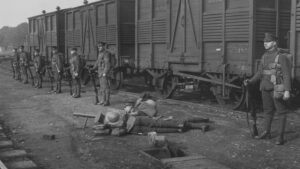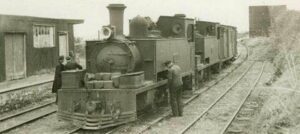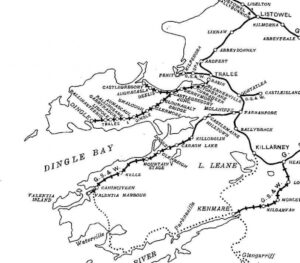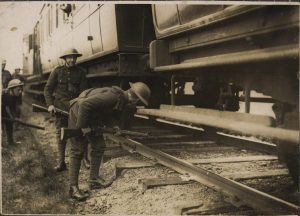Kerry and the 1920 Railway Munitions Strike: How workers defied an Empire.

By Kieran McNulty
From late May to December 1920 the railway unions in Ireland took part in a national munitions strike, refusing to carry Crown forces or their equipment.
The strike was particularly well supported in Kerry causing considerable disruption to British military logistics and rendering the transportation of Crown forces in the county impossible at times.
The labour movement had already proved its value to the struggle for independence with the general strike of 1918 which ensured conscription was defeated.
The labour movement in Ireland called three general strikes between 1918 and 1920.
In April 1920, the Irish Labour Party and Trade Union Congress (ILPTUC) called a third general strike in two years,[1] on this occasion in support of republican and trade union activists who had gone on hunger strike in protest at being imprisoned without charge.
The Kerryman ran with the headline ‘The Triumph of Labour. Business Completely Paralysed’.[2] The strike proved to be a great success and within a few days the majority of prisoners were released. Arguably, however even more significant was the strike by the railway workers in protest over the British military use of trains. This action is dramatically brought to life in Ken Loach’s 2006 film, The Wind that Shakes the Barley, where the train driver (played by Liam Cunningham) refuses to transport armed members of the Crown forces and is viscously attacked by the soldiers.
The start of the strike
 The industrial action on the railways was preceded on 25 May 1920, by industrial action on the docks in Dublin, when workers refused to handle supplies bound for the Crown force. On 27 May they were joined by the railway workers, who also refused to transport armed troops.
The industrial action on the railways was preceded on 25 May 1920, by industrial action on the docks in Dublin, when workers refused to handle supplies bound for the Crown force. On 27 May they were joined by the railway workers, who also refused to transport armed troops.
Charles Townsend has argued that ‘undoubtedly the men involved saw in their action a parallel with the “hands off Russia” campaign waged by the British workers against the export of munitions to Poland’ [for its war against Soviet Russia], hoping their boycott would receive similar support from the leadership of the British labour movement. But the conservative leadership of the British unions, as Townsend also maintains, ‘fought shy of the Irish action with its anti-British implications’ giving it ‘no direct assistance’.[3]
In May 1920, Irish railway workers began to refuse to carry British troops or munitions, by that summer the strike had spread around the country.
According to Conor McCabe,
‘… strong elements within the British labour leadership, including J.H. Thomas, (NUR, General Secretary) … made it clear that the democratic wishes of Ireland … were to be treated differently from those of Russia because, unlike Russia, Irish independence posed a threat to the Empire’.[4]
The Kerryman in its caustic editorial of 12 June noted that when the National Union of Railwaymen (NUR), ‘… issued a probation against the handling of munitions for Poland, the Irish railwaymen applied the same principle in Ireland’ yet the union refused to back their Irish members. The editorial went onto make reference to what it saw as,
[T]he subservience, servility and utter abjectness of the English Labour Party to the British Government in connection with the refusal of the Irish Transport and General Workers Union and Railway employees to handle munitions of war destined for this country.
The editorial also argued that Irish workers, who were members of British based unions including the NUR, would be better served leaving these unions and forming Irish based unions, following the example of the Irish Transport and General Workers’ Union (ITGWU) and the Irish Drapers’ Assistants’ Association.[5]
Despite this, the Irish members of the NUR remained resolute with almost no trains operating anywhere in Munster, including Kerry, by the end of June and by the end of July the Great Southern and Western Railway had dismissed over 600 staff, or about ten per cent of its workforce.[6] In the same month the railway unions declared that no trains would be worked which carried ‘materials designed for the destruction of life and property’, or ‘armed’ troops or police.[7]
The strike in Kerry

The railway unions had significant influence on Tralee Trades Council with J. Lenihan representing the NUR and D. Moynihan representing the Associated Society of Locomotive Engineers and Firemen.[8] By 1920 the ITGWU had 20 branches and 2,147 members in Kerry.[9]
By now the strength of the labour movement in the county was such that of the total of 45 councillors elected in the municipal elections of January 1920, a total of 12 were members of the Labour Party including a member of the NUR.[10]
In terms of industrial action a significant escalation of militancy by workers in Kerry in support of the republican movement began in November 1919 when the Irish Automobile Drivers Union went on strike in protest at being obliged to have permits signed by the military.[11]
The labour movement had a significant presence in county Kerry and the railway munitions strike was taken up enthusiastically.
It was from this record of union organisation and militancy that a few months later the railway workers in Kerry went out on strike. The effectiveness of the railway strike in the county is shown by a report which appeared in the Irish Times on Friday 30 July:
‘Trains stopped in Tralee – armed soldiers who remained in a railway carriage at the Tralee terminus of the Dingle railway from Saturday morning until three o’clock on Wednesday afternoon when they were withdrawn, returned on Thursday morning. The railway men again refused to work the train, and traffic has been once more suspended’.[12]
According to the Kerryman the ‘mails were conveyed to Dingle by motor’, and it declared that the industrial action meant that ‘[T]he service on the line as a result, is almost completely disorganised’.[13] Actions took place elsewhere in Kerry, for example in Dingle on 8 June, as also reported by the Kerryman, ‘…soldiers armed and equipped’ travelling to Tralee,
…took their seats in the train. When the time came for starting the driver, fireman and guard left the train refusing to take charge of it unless the military left. After a delay of 35 minutes the military party bowed to the inevitable, left the train and returned to their camp. The affair caused a good deal of excitement.[14]
As revealed by Peter Rigney, the industrial action by railway workers in Tralee and Dingle was significantly aided by the fact that ‘the stationmasters’ in these towns ‘were both IRA intelligence officers’ who refused to discipline the train crews.[15] At Killorglin station, railway staff ‘refused to handle seven boxes of ammunition which were being sent by rail to Caherciveen’.[16]
Railway workers found to be cooperating with the crown forces and undermining the industrial action were dealt with by the republican courts, which in one instance resulted in a railway inspector being kidnaped at Gortatlea[17] and in another case a guard in North Kerry was fined £12 by an IRA court-martial for ‘agreeing to carry, among other passengers, armed RIC’[18].
The strike wavers

As the dispute dragged on into December, the leadership of the Irish labour movement were becoming less enthusiastic. Fifteen hundred drivers had been sacked and union financial resources were nearing exhaustion. The union leadership had the choice to either escalate the boycott or surrender.
They chose the latter course of action, and when Martial law was declared on 10 December, the next day the ILPTUC leadership called for an honourable end to the boycott claiming that the military regime now made it impossible to effectively organise industrial action, and further explained its instructions by stating,
In the circumstances thus created the Executive met to consider the position and decided to advise the railwaymen and dock workers to alter their decision and to offer to carry everything that the British Military Authorities were willing to risk on the trains.[19]
According to Rigney, ‘The railwaymen had gone as far as they could go and decided to follow the advice of Congress’.[20] However, as Townsend argues, throughout this dispute, the conservative ILPTUC leaders had ‘displayed extreme caution’. [21]
As the dispute dragged on into December, the leadership of the Irish labour movement were becoming less enthusiastic
Conor Kostick asserts that the escalation of the strike would also ‘mean challenging the employers’ and breaking with the notion of class unity. This was not a course of action labour leaders including Thomas Johnson and Thomas Foran favoured and they won the debate because no radical alternative union leadership existed.[22] Despite what seems on the surface a defeat for the labour movement, Townsend asserts that,
‘… the Irish railway strike cannot and should not be evaluated in purely military terms. Its intended effect was as much moral as physical, and its moral force must by any account be reckoned considerable … Ireland’s struggle for independence was, fundamentally, a struggle not for military victory but to impress upon Britain the seriousness of Ireland’s claim’.[23]
Kieran Allen supports this contention and argues that ‘The fact remained, however, that workers’ action had hampered the activity of the British war machine for six months’.[24] Seen in this light the strike represented a propaganda victory for all those claiming Dáil Éireann was the only legitimate government in Ireland. Tellingly McCabe also perceptively observes that,
The point of the strike, however, was not military. It did not form part of a republican strategy though it was welcomed and supported by that movement … The Irish people had voted democratically for a republic, and that needed to be respected and accepted without violence.[25]
Even so, there remained a legacy of bitterness especially towards the leadership of the British labour movement. When a delegation from the British Labour Party arrived in Ireland on a tour of investigation, the Kerryman remained suspicious in the light of ‘the marked apathy displayed by British workers towards Irish affairs during the recent critical years’.[26]
However, it was the lack of solidarity for the Irish railway workers shown by the leadership of the British labour movement that hampered support from the British trade union rank and file. The end of the railway strike may also have had a tactical effect allowing greater numbers of Crown forces to be transported by rail into West Cork and Kerry. This in turn also led to a series of train ambushes including at Headford Junction, Killarney where, on 21 March 1921seven soldiers of the Royal Fusiliers Regiment were killed by the Kerry No. 2 Brigade of the Irish Republican Army (IRA).[27]
In sharp contrast to the IRA’s military campaign, the industrial action on the railways during 1920 provided an alternative non-violent strategy of resistance to British imperialism for the trade union rank and file in the form of mass civil disobedience.
Also, unlike the Republicans, by its very nature, industrial action organised through the trade union movement gave ordinary workers a deeper understanding of their own power and a greater sense of ownership of the independence struggle.
The experience also reinforced in the consciousness of many workers in Kerry the power they possessed as part of the organised working-class. Despite the extreme caution displayed by the ILPTUC, who in December 1920, warned union members in Tralee that Congress was opposed to them ‘even talking’ of taking strike action,[28] many workers in Kerry began to realise the full extent to which the potential of their industrial power could also be utilised to win economic as well political gains.
Notes
[1] There had also been another general strike on May Day 1919 in support of a workers’ republic.
[2] Kerryman, 17 April 1920.
[3] Charles Townsend, ‘The Irish railway strike of 1920 industrial action and civil resistance in the struggle for independence’ in Irish Historical Society, XXI (83), (1979) , pp. 267-8.
[4] Conor McCabe, ‘A situation of great novelty and difficulty: The 1920 Irish Munitions Strike’, in Saothar, 45, (ILHS, 2020), p. 17.
[5] The Kerryman, 12 June 1920.
[6] Peter Rigney, The Irish munitions embargo of 1920: how railwaymen and dockers defied an empire, (Dublin, 2021), Umiskin Press, p. 18.
[7]. Townsend, ‘The Irish railway strike of 1920’, p. 269.
[8] Liberty, June 1981.
[9] Francis Devine, ‘The Irish Transport & General Workers’ Union in Kerry, 1909-1930’, Journal of the Kerry Archaeological and Historical Society, Series 2, Vol. 20 (2020), p. 107.
[10] Irish Opinion-The Voice of Labour, 31 January 1920.
[11] Kieran McNulty, ‘War and the working-class in Kerry 1919-1921’ in Saothar: Journal of the Irish Labour History Society, (Vol. 42, 2017), pp. 43-52
[12] Irish Times, 30 July 1920.
[13] Kerryman, 24 July 1920.
[14] Kerryman, 12 June 1920.
[15] Rigney, The Irish munitions embargo of 1920, p. 25.
[16] Kerryman, 12 June 1920.
[17] Kerryman, 26 June 1920.
[18]Kerryman, 28 August 1920.
[19] Irish Labour Party and Trade Union Congress Report of the twenty-seventh Annual Meeting held in the Mansion House, Dublin, 1-4 August 1921, (Dublin, 1923), National Executive, pp. 6-13, https://centenaries-ituc.nationalarchives.ie/wp-content/uploads/2014/10/27th-annual-report-1921.pdf [accessed 3 March 2020].
[20] Rigney, The Irish munitions embargo of 1920, p. 38.
[21] Townsend, ‘The Irish railway strike of 1920’, p. 280.
[22] Conor Kostick, Revolution in Ireland: Popular Militancy 1917-1923, (Cork, 2009), Cork University Press, p. 146.
[23] Townsend, ‘The Irish railway strike of 1920’, p. 282.
[24] Kieran Allen, 1916: Ireland’s revolutionary tradition, (London, 2016), Pluto Press, pp. 73-4.
[25] McCabe, ‘The 1920 Irish Munitions Strike’, p. 16.
[26] Kerryman, 4 December 1920.
[27] Kerryman, 26 March 1921, Kerryman, 2 April 1921, Eunan O’Halpin and Daithí Ó Corráin, The dead of the Irish revolution, (New Haven and London, 2020), Yale University Press, pp. 350-2.
[28] Tralee 1921, Wages’ movement and disputes, Tralee 1920 file, (ILHS), correspondence from Thomas Farren to Jeremiah Murphy , 8 December 1921. O’Connor suggests little effort was made by the Labour leadership to challenge the rise of Sinn Fein, Syndicalism in Ireland, pp. 83-5.